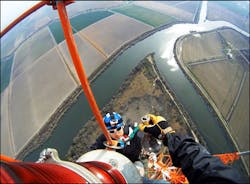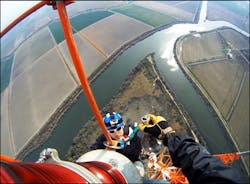A narrator explains that the worker takes an elevator up to 1,600 feet and “after that, it’s all about climbing.”
A minute or two later, as the worker moves outside of the enclosed ladder on the tower and onto the exposed pole on which the antenna is mounted, the narrator says, “This is called free climbing, meaning that no safety lines are used. It’s easier, faster and most tower workers climb this way.”
He goes on to say, “Free climbing is more dangerous of course, but OSHA rules do allow for it. Attaching, climbing, attaching and removing safety lines every few feet slows progress and is tiring.”
We know that OSHA regulations do NOT condone free climbing and I guarantee any employer who allows it will find that out should an OSHA investigator happen to drive past the tower. The National Association of Tower Erectors publicly denounced the video and its message, calling the posting of the content “misguided.”
The video “suggests that free climbing is an accepted method of ascending and descending broadcast and telecommunication towers. The video incorrectly asserts that free climbing is accepted by OSHA and that ‘most tower workers climb this way,’” NATE noted. “The video also depicts as standard procedure other dangerous and prohibited conduct not condoned by NATE or OSHA. There are many inaccuracies in this video.”
Don’t get me wrong; the footage displayed in the video is breathtaking (particularly if you’re afraid of heights, like me). Also breathtaking is the lack of concern for the safety of the workers climbing the tower.
The safety attitude (or lack of one) displayed in the video is an interesting juxtaposition against the cover story of EHS Today’s September issue: “One World Trade Center: Safe at 1,776 Feet.” The article discusses the fall protection systems utilized at the iconic structure to protect the maintenance workers who must access the communications equipment in the tower of the building. These workers have provided positive feedback about the ease-of-use of the fall protection system and none of them have called it an inconvenience or think that it acts as a deterrent to them doing their jobs.
In response to the Stairway to Heaven video, Nick Bassarab and Todd Horning from Safety One Training Inc. climb to the top of a 1,700-foot tall tower to change a couple light bulbs while using 100 percent attachment the whole time (the photo that accompanies this blog post is from Safety One Training and depicts safe climbing practices). Their video, “Stairway to Safety,” has 113,740 views. Let’s see if we can get the video showing safe climbing up to 1 million or more views.
About the Author
Sandy Smith Blog
Content Director
Sandy Smith is content director of EHS Today. She has been writing about occupational safety and health and environmental issues since 1990. She has been interviewed about occupational safety and health for national business publications,documentaries and television programs, has served as a panelist on roundtables, has provided the keynote address for occupational safety and health conferences and has won national and international awards for her articles.

